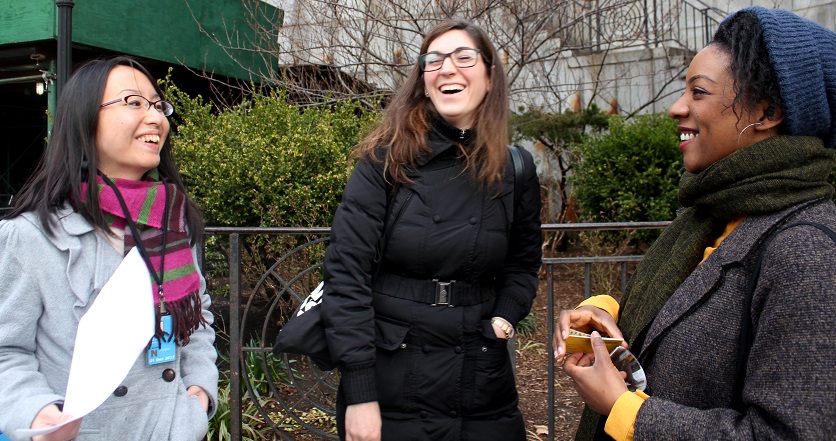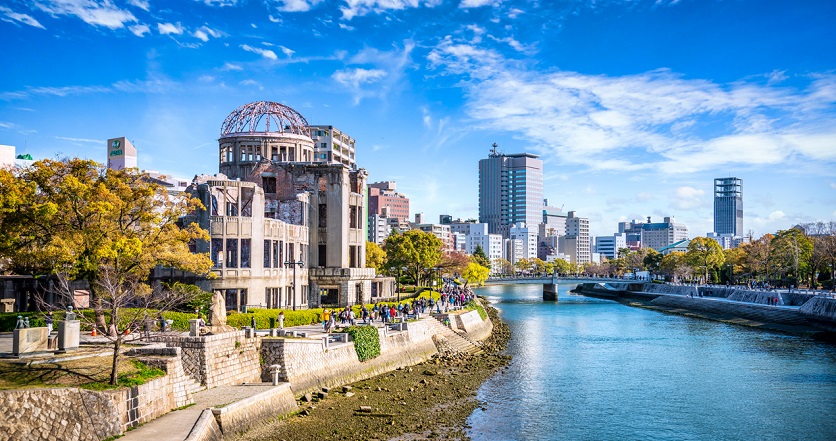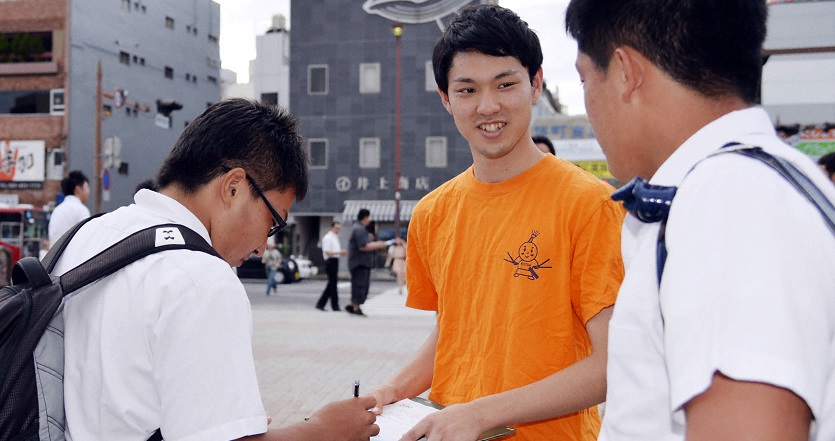Doing What We Can: A Conversation with Beatrice Fihn
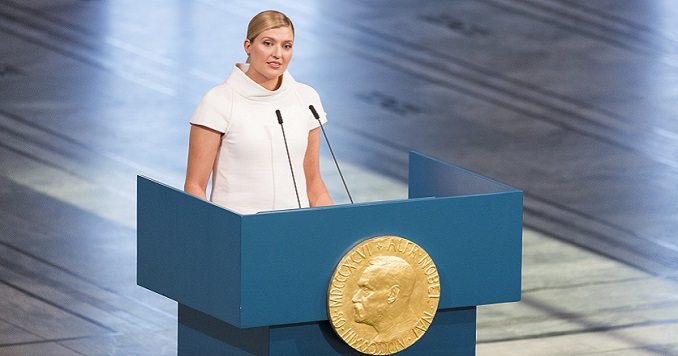
Beatrice Fihn is the executive director of the International Campaign to Abolish Nuclear Weapons (ICAN), “a coalition of non-governmental organizations promoting adherence to and implementation of the United Nations nuclear weapon ban treaty,” of which the SGI (Soka Gakkai International) is a member. ICAN’s efforts were instrumental in the adoption of the Treaty on the Prohibition of Nuclear Weapons (TPNW) in July 2017, in recognition of which it was awarded the Nobel Peace Prize that year. Ms. Fihn spoke with the Soka Gakkai’s Seikyo Shimbun newspaper in January 2021 about the work of securing a world free from the threat of nuclear weapons and ICAN’s partnership with the SGI.
On October 24, [2020,] Honduras became the 50th country to ratify the UN Treaty on the Prohibition of Nuclear Weapons (TPNW), fulfilling the requirement for the treaty to enter into force. Where were you when the news broke?
We were very closely in touch with the Honduras government and several other governments that were racing to get the ratifications done before the end of the year. We were in touch with them throughout the whole day. And when they had sent the ratification, the UN Office of Legal Affairs confirmed that they’d received it, that it was all in order and that they would process it.
We have to stop these things before they happen. Because you can’t lock down and find the vaccine against nuclear war. Once it happens, it’s too late.
It was a great feeling, of course. In one way, it’s just a ratification. But, obviously, getting to this landmark and making sure that the treaty enters into force was really meaningful. And particularly, that it happened almost as a result of the 75th anniversary of Hiroshima and Nagasaki. We really saw a lot of attention on nuclear weapons at that moment, which generated a lot of interest also amongst governments. There was a clear feeling amongst governments that the way we honor the survivors is through ratifying this treaty.
The hibakusha [atomic bomb survivors] have been a very instrumental part of our campaign and have been activists and campaigners and public educators since the beginning. They are the reason we’re doing this work. The reason we even have a treaty is to make sure that what happened in Hiroshima and Nagasaki doesn’t happen to any other city, and the hibakusha testimonies are a driving force behind this. So, it was a really great moment for the whole campaign.
It has been over three years since the adoption of the TPNW in 2017. How do you evaluate these three and a half years?
I think it was really hard for us to know in advance how much time it would take [to reach the required 50 ratifications]. We had some hope that we could make it in maybe three or two and a half years. But we also knew that it could take a lot longer. It’s something that has to go through a lot of different procedures. So, we always set very ambitious goals.
I think it’s had a very good pace compared to other weapons of mass destruction treaties. At first, we were quite worried that the pandemic would slow the processes down completely, but rather it was the opposite.
What do you think was the key to achieving 50 ratifications?
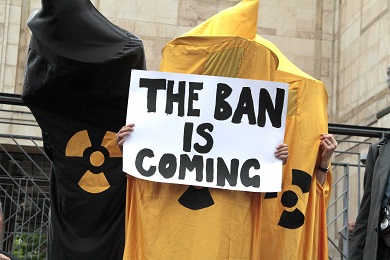
It would’ve gone faster and easier, I think, if the nuclear-armed states weren’t so aggressively pushing back on this treaty. But the fact is that a lot of countries with very good relationships with the nuclear-armed states are going ahead with ratification because they’re really committed to the issue. It’s not easy for small countries to stand up and challenge the most powerful countries in the world, but the fact that 51 now have done that is a huge sign that this is a very important issue to these governments. They do believe that this treaty is the way forward. I think that’s a huge sign.
For us, we don’t take any government for granted. Each government is really taking us closer to the eventual elimination of nuclear weapons. I think that’s really important to remember.
How, specifically, do you think the TPNW influences the current state of nuclear disarmament?
For almost 75 years, we have had a narrative and a conversation that it’s okay for some countries to have nuclear weapons. One of the most important things about the treaty is that it completely prohibits all nuclear weapons. It’s going to be international law, and those countries are going to have to relate to it in some way.
Until now, nuclear weapons have been seen almost as a positive thing. Possessing nuclear weapons gives you power. It gives you influence. I mean, look at North Korea. It has very little power and influence in the world, but somehow, because they have nuclear weapons, when President Trump and Kim Jong-un met in Singapore, it was almost like a meeting of equals.
I think that’s a very dangerous narrative, that we allow nuclear weapons to be so important and confer so much prestige and power. So, really what the treaty is supposed to do is place some shame, some stigma, some difficulties on nuclear weapons—not just for the governments that have nuclear weapons, but the governments that support nuclear weapons. It puts pressure on the companies that make nuclear weapons. It puts pressure on the banks and pension funds that invest in those companies. It puts pressure on the universities where researchers and staff are building nuclear weapons.
When you’re in Hiroshima and Nagasaki, standing there . . . you understand that these weapons are still around, and they can do this within a few seconds’ notice.
The treaty is turning up the pressure in all these different ways and making nuclear weapons controversial, difficult, awful and shameful. I think that’s the only way we’re going to see nuclear weapons eliminated, if their status disappears, and they become a problem and a difficulty and source of shame.
In 2018, you visited Hiroshima and Nagasaki and had conversations with hibakusha in Nagasaki. During the visit, you emphasized that the leaders of nuclear-weapon states should visit Hiroshima and Nagasaki and listen to the hibakusha.
It’s extremely powerful when you’re there, and I think one of the challenges with nuclear weapons is that they’re so abstract to most people. People haven’t seen any nuclear weapons, they don’t know what they do—[the nuclear weapons issue] seems like a technical, almost theoretical matter.
When you’re in Hiroshima and Nagasaki, standing there, you understand that these are real weapons; you understand that these weapons are still around, and that they can do this within a few seconds’ notice.
I think a lot of the leaders of the decision-making states don’t want to think about that. They want to use their weapons to threaten, but they never think about what happens after a nuclear weapon is used.
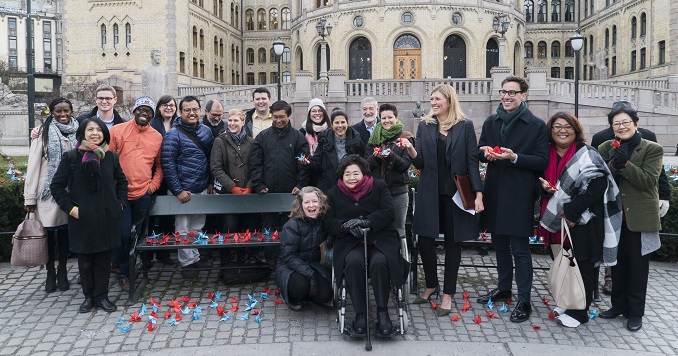
So, I think it’s extremely important for them to visit [Hiroshima and Nagasaki], to stand there, to listen and to really understand what it means to use these weapons. Their experts know nothing about nuclear weapons. The survivors are the experts on nuclear weapons. They know what it looks like, how it feels, what happens to your family, what happens to your city. That’s the kind of knowledge that leaders need to have, because they are the decision-makers in this.
Do you think this pandemic has had some kind of influence on the narrative around nuclear weapons?
We’ve been a little bit careful to not push people who are suffering right now—who are sick or facing unemployment. You can’t be too aggressive in asking them to think about and prioritize your issue, nuclear weapons.
But then you can find other angles. For example, this is what security looks like in the 21st century. We’re fighting a pandemic, we’re fighting climate change, and nuclear weapons are useless in combating those threats. You can also connect it in a broader sense: They drain resources—in the United States, over 300,000 people have died, but they don’t have [universal] healthcare, they don’t have unemployment benefits, they don’t have the kinds of measures to actually protect people in this situation. But they’re spending all this money on nuclear weapons.
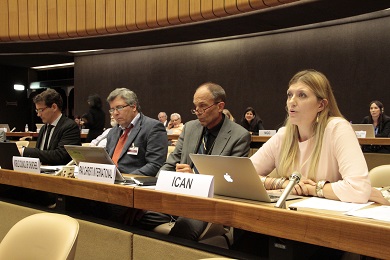
Right now, to protect people, you need to take care of them, you need to stand in solidarity, you need to think long term, you need to think healthcare, you need to think social services. That’s how you protect your people right now in this crisis.
In that way, I found that people have really been open to thinking about how we protect ourselves, and nuclear weapons are a part of that. I think we have to be creative.
Another thing that I think is also important is to think about scientists and the role that they’ve played. I’ve heard numerous experts for decades warning that there will be a pandemic; the same thing with climate change. Scientists are saying that it’s going to be bad, and we can see their predictions playing out. Scientists are also saying that the risk of nuclear war is increasing and that eventually nuclear weapons will be used.
So, I think people are also starting to understand that these kinds of worst-case scenarios are going to happen if we don’t do anything about it. We have to stop these things before they happen. Because you can’t lock down and find the vaccine against nuclear war. Once it happens, it’s too late.
We have to learn to cooperate, and maybe this pandemic will be a step toward collaboration and cooperation on abolishing nuclear weapons and fighting climate change.
Absolutely. I think we’ve seen that when big things happen that change our world, new and better things can come out of it. For example, World War II was extremely devastating and awful. But faced with that, people started building multilateral institutions—the United Nations, the European Union, the ASEAN grouping—and these kinds of groups started investing in treaties. We had the Biological Weapons Convention, we had the Geneva Conventions on civilians and warfare, [treaties on] chemical weapons, landmines, gas emissions, non-nuclear weapons. Obviously, it’s not complete, and it’s not that it’s flawless all the time, but I think since World War II, we’ve drastically changed the way we cooperate in the world.
Most people, as polls show, don’t like nuclear weapons and don’t want them around, but they don’t feel like they can do anything about it.
I think that this pandemic can lead to similar things in the future. It might be very difficult to see it when you’re in it. But I imagine that in January 1946 things didn’t look clear. The United Nations maybe also didn’t look like it was going to work. In a few years, maybe we can see that things have changed for the better. But we can’t take it for granted. We have to do it.
What do you say to those who think they are powerless to help bring about any change on the issue of nuclear weapons?
This is really important to talk about because most people, as polls show, don’t like nuclear weapons and don’t want them around, but they don’t feel like they can do anything about it. That’s really the opposite of what’s true. There’s so much to do on this issue, and ICAN and the treaty are an example of that. This is really an initiative by individuals, by regular people who started talking about an idea and working with governments. Even on the government side, it’s individuals.
Sometimes, when we talk about nuclear weapons, we focus very much on the leaders of the nuclear-armed states—it’s Trump, Putin, Kim Jong-un and Macron, and it feels very far away from oneself; like, “How can I change Trump’s mind?” I can’t. So, we have to look at what’s around us, and what’s around us is, of course, our own governments. But also, our pension funds, our banks, our cities, our universities, our trade unions, our churches and faith organizations. There are so many other networks and groups of people and communities that are influential in shaping the world. I think that we sometimes look too far toward the end goal and forget to look at the things around us and what we can impact.
That’s really one of the powers of coalitions like ICAN—to bring all these small groups together so people feel like, “OK, I can’t change my government’s mind, but I can start a group at my university, and I can start talking to my bank,” for example. When you connect that with all the other groups working on different things, you see how it all fits together. This can really change things and move big global issues forward.
It’s really important to look at both the small things you can do on a local and national level and how it fits together with the big global picture. For example, I think the SGI is really amazing. When I travel, in almost every country there’s a Soka Gakkai organization, a local Soka Gakkai member that comes up. I think it’s a really nice way to work, to keep a local perspective, but also connect globally.
Can you describe the relationship between ICAN and the SGI?
The SGI is one of our partner organizations and one of the organizations that we have teamed up with so much throughout this campaign. It’s been such an honor to work so closely with SGI people, of course at the headquarters in Tokyo but also all around the world.
I think that that’s where faith-based communities have a real strength, in being able to mobilize and encourage people to really get involved.
We’ve had such strong partnership with the SGI on many issues—the general campaign work, the work in Japan, work with faith-based communities—and I think that the SGI is taking a leading role in our campaign.
We’ve had some really great projects—a wide range of projects—but in particular, things like regional meetings. For example, we worked with the SGI on a project in the Caribbean region.
By working with the SGI to organize a regional conference that brought together diplomats from the different Caribbean countries with experts and included presentations from the SGI and from ICAN, we managed to achieve some really great results.
Quite quickly afterwards, in the following six or seven months, we saw a number of Caribbean states sign and ratify the treaty. To the point that now, a year and a half after this meeting, almost all Caribbean countries are a part of the treaty. There are a few that aren’t, but it’s one of the regions with most support.
Without that meeting, we wouldn’t have reached 50 [ratifications] today, because many of these 50 are the Caribbean states that came through after this regional meeting.
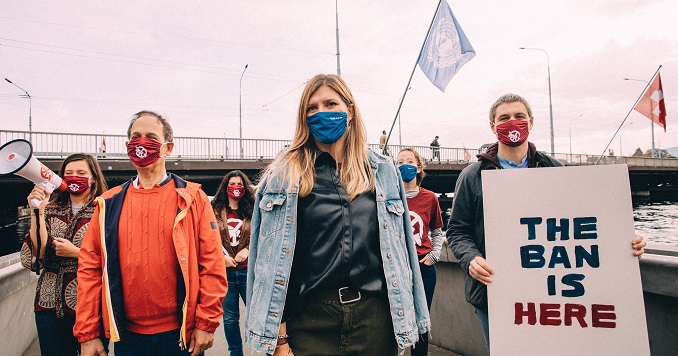
Also, we’ve worked with Soka Gakkai members around the world and with other faith-based communities to help educate and mobilize the public about this issue. I think religion and faith have been part of getting people to move and act; you can give people all the facts, but it’s when they feel things, feel that they’re part of something, that they take action. I think that that’s where faith-based communities have a real strength, in being able to mobilize and encourage people to really get involved.
The work toward the total abolition of nuclear weapons is a marathon, not a sprint. We are very eager to continue working with the SGI and deepening our work together in many different ways.





